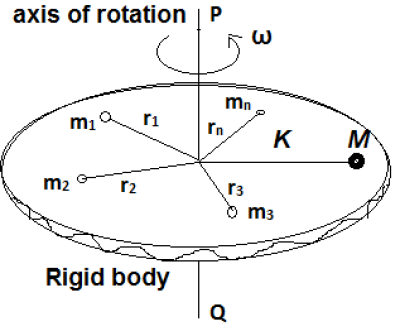Course description
Radius of gyration or gyradius refers to distribution of the components of an object around an axis. In terms of mass moment of inertia, it is the perpendicular distance from the axis of rotation to a point mass (of mass, M) that gives an equivalent inertia to the original object(s) (of mass, M). The nature of the object does not affect the concept, which applies equally to a surface, a bulk mass, or an ensemble of points. Therefore, radius of gyration is the distance from an axis at which the mass of a body may be assumed to be concentrated and at which the moment of inertia will be equal to the moment of inertia of the actual mass about the axis.
Mathematically the radius of gyration (K) is equal to the square root of the quotient of the moment of inertia (I) and the mass (M).
Fig. 40
Polar moment of inertia:
Polar Moment of Inertia is measure of an object’s ability to resist torsion under specified axis when a torque is being applied. It is utilized to calculate the angular displacement of a body subjected to torque. Higher the polar moment of inertia, the less the object will twist after torque is applied. The polar moment of area can be utilized to calculate the moment of inertia with arbitrary cross-section. Therefore, it is analogous to the area moment of inertia, which characterizes an object's ability to resist bending and is required to calculate displacement (Fig. 41a). The larger the polar moment of area, the less the beam will twist, when subjected to a given torque. “Polar Moment of Inertia is also called “Second Moment of Area“, “Area Moment of Inertia“, “Polar Moment of Area” or “Second Area Moment“.
The SI unit for polar moment of area, like the area moment of inertia, is meter to the fourth power (m4). Following the Fig. 41b, the polar moment of area, .Iz=∫ ρ^2 da
where, Iz = the polar moment of area about the axis z
dA = an elemental area
ρ = the radial distance to the element dA from the axis z
For a circular section with radius r:
(a) (b)
Fig. 41
Moment of Inertia vs. Polar Moment of Inertia:
A quantity expressing a body’s tendency to resist angular acceleration is known as the Moment of Inertia, whereas Polar Moment of Inertia is measure of an object’s ability to resist torsion under specified axis when a torque is being applied.
Polar Moment of Inertia is utilized to calculate the angular displacement of a body subjected to torque.
The polar moment of area can be used to calculate the moment of inertia with arbitrary cross-section.
The mathematical representation of Moment of Inertia is I=∫ 〖r^2 dm〗, while Polar Moment of Inertia can be defined mathematically as I=∫ 〖r^2 dA〗.
In Moment of Inertia units of kg m2 are used for measuring, on the other hand, in polar moment of Inertia units of m4 are used for measuring.
Fig. 42
Problem 9: Determine the moment of inertia and radius of gyration with respect to a polar centroidal axis of the cross section of a hollow tube whose outside diameter is 6 in. and inside diameter is 4 in as shown in the Fig. 43.
Solution: Polar moment of inertia,
Radius of gyration,
Fig. 43


















